Content
- 1 What is ghee
- 2 Composition and calorie content of ghee
- 3 Why ghee is useful
- 4 Can ghee for children
- 5 Ghee treatment
- 6 The use of ghee in cosmetology
- 7 How to make ghee at home
- 8 Can you fry in ghee
- 9 Which is healthier: ghee or butter
- 10 The harm of ghee and contraindications
- 11 How to store ghee
- 12 Conclusion
- 13 Reviews
The benefits and harms of ghee have been known for a long time. This product has been used in traditional cuisines of some peoples for several centuries. It differs from ordinary butter in greater usefulness, improved properties and a long shelf life. Its use is not limited to cooking: this oil is used in cosmetology and medicine.
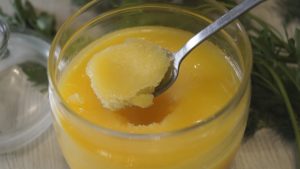
What is ghee
Melted butter is a dish of Russian and Indian cuisine. This product is used not only in cooking but also in medicine. Heat treatment of butter changes its properties: components of milk fat are melted out of it, which makes it more useful.
This removes water, some milk constituents and many impurities from the product. In fact, only pure fat remains of the original components.
This fat can be heated to a temperature of about +200 ° C, while it does not form carcinogens, and it does not burn. This means that there will be no foam or smoke when frying. In addition, such a procedure significantly extends its shelf life.
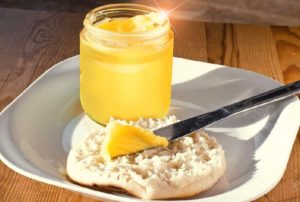
Composition and calorie content of ghee
The oil contains the following components (per 100 g of product):
- vitamin A - 660.0 mcg;
- vitamin B2 - 0.12 mg;
- vitamin B5 - 0.04 mg;
- vitamin E - 1.5 mg;
- vitamin D - 1.8 mg;
- vitamin PP - 0.1 mg.
The product also contains provitamin A (beta-carotene), cholesterol and water residues. The share of the last two components does not exceed 1%.
The mineral composition of the product is as follows:
- iron - 0.2 mg;
- potassium - 5.0 mg;
- calcium - 6.0 mg;
- magnesium - 0.4 mg;
- zinc - 0.1 mg;
- phosphorus - 20.0 mg.
It also contains manganese, copper and zinc.
The calorie content of the product is 892 kcal. It consists of almost 99% fats, proteins in it about 0.2%.
Why ghee is useful
The benefits of ghee for the body are as follows:
- improvement of digestion due to the normalization of the digestive tract (vitamin PP, sodium, phosphorus);
- strengthening of immunity (due to the content of zinc and copper);
- reduction of headaches and migraines (vitamin B5 and potassium);
- strengthening bones and joints, maintaining their good shape (calcium, phosphorus, vitamin D);
- improving the work of the cardiovascular system (potassium, iron, magnesium, vitamin E);
- improvement of metabolism, the work of the immune system (vitamin B5, copper, zinc);
- prevention of atherosclerosis, diabetes, antioxidant properties (provitamin A).
The benefits of homemade ghee are shown in the treatment of many diseases (rickets, osteoporosis, colds, sciatica, and others); it is used for injuries - bruises, fractures, wound healing.
It is also used in cosmetology, helping to maintain a healthy appearance of skin and hair.
For pregnant and lactating women
The benefits of ghee for women are manifested primarily during pregnancy. As a product rich in vitamins A, E and D, oil is simply irreplaceable. The absence of these vitamins can lead to fetal pathologies.When breastfeeding, a set of these vitamins, as well as phosphorus and calcium, will be beneficial for the baby.
In addition, ghee, rich in medium-chain fats, is much better absorbed in the pregnant woman's body than butter, since bile is not required to break them down.
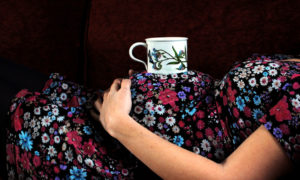
For the elderly
The elderly will benefit from this product primarily due to its ability to restore joint health. Not the least role is played by the normalization of the processes occurring in the brain. By using the product in old age, you can maintain clarity of thinking for a long time.
Can ghee for children
Children can eat this product only after the formation of a full-fledged gastrointestinal tract, that is, after they reach 10-12 months of age. The rules and regulations for its use are similar to the use of ordinary butter. There are practically no contraindications, since its allergenicity is very low.
The use of ghee is much more preferable than butter: it is more easily absorbed by the body and does not contain any traces of lactose.

Ghee treatment
In folk medicine, ghee is used to treat and prevent various diseases:
- Angina. Take orally 1 tbsp. l. every 2-3 hours with the addition of a small amount of turmeric. At the same time, it is strongly recommended to lubricate the throat from the outside once a day.
- Flu. The oil is mixed with finely ground black pepper in a ratio of 1 to 30. Three times a day after meals, it is necessary to slowly dissolve 1 tsp. mixtures.
- Hypothermia. In this situation, in order to avoid illness, you should, when you come home, rub oil on your back and feet.
- Inflammation of the intestines. Dissolve in 1 tsp. pure oil half an hour before meals.
- Constipation. Make a compress on the lower abdomen with melted butter.
- Radiculitis. Heated oil with a temperature not higher than +45 ° C (i.e. actually melted) is applied to the back in the lumbar region, where it is kept for up to 40 minutes. To prevent the liquid from spreading, "sides" should be made on the back in the lumbar region, for example, from dough.
- With fractures. The product should be eaten in a mixture with cottage cheese in a 1 to 1 ratio once a day, preferably for breakfast.
- With bruises and sprains. The product alone or mixed with rye and cinnamon is applied locally to the site of injury.
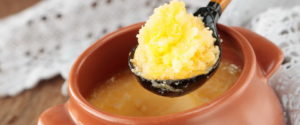
The use of ghee in cosmetology
In cosmetology, oil is used to create masks for hair and facial skin. Its beneficial properties can moisturize the skin, prevent flaking, smooth wrinkles and remove minor blemishes. Hair treated with it has a healthy look, it becomes more durable.
Facial masks
Preparation of a mask for dry and normal skin:
- in a small container, mix 1 tbsp. l. ghee and 1 yolk;
- mix thoroughly and wait 2-3 minutes;
- apply on face for 20-30 minutes;
- wash off with warm water.
A mask for oily skin is made according to the following recipe:
- 1 tbsp is steamed in water. l. with a slide of oatmeal for 5 minutes;
- flakes are harvested in a separate container and 1 tbsp is added to them. l. product;
- the components are thoroughly mixed;
- after 1 min. half of tbsp is added to the resulting mixture. l. liquid honey, and the mixture is mixed again;
- a pinch of turmeric is added to the mixture.
The mask is applied to the face, where it is kept for 30 minutes, after which it is washed off with warm water. Re-use of such a mask is allowed after 10-15 days.
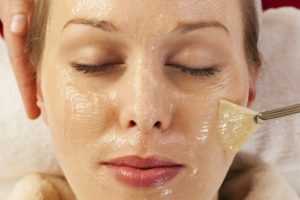
Hair masks
The simplest recipe for a nourishing hair mask is to simply apply the product to your hair and cover your head with a plastic cap for half an hour. Then the mask is washed off with shampoo. It is not recommended to do this procedure more than 1-2 times a week. If your hair is oily, you can add a few drops of eucalyptus extract to the mask.
A regenerating hair mask is done as follows:
- ghee, olive oil and milk are mixed in equal proportions;
- 2-3 drops of castor extract are added to the mixture;
- the mask is applied to the hair, and also rubbed into the scalp;
- it is necessary to keep the mask on the hair for 20 minutes, then rinse with shampoo.
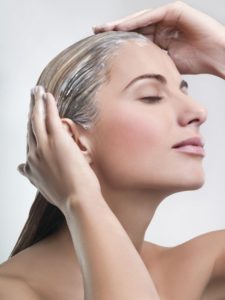
How to make ghee at home
For cooking, you need 72% fat butter. Homemade is preferable. It should be cut into pieces and placed in a dry container.
The beginning of heating is carried out on a medium-intensity fire. As soon as the solid pieces have melted, the intensity of the fire is reduced to a minimum. As the foam appears, it should be removed.
As sediment appears, pour the liquid into a new container and continue the process. When there is practically no sediment left, the procedure can be considered complete. Cooking time for 1 kg of product is about 1-1.5 hours.
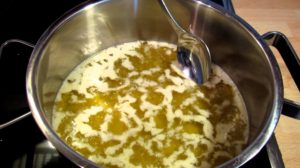
Can you fry in ghee
Ghee is perfect for frying. Its boiling point is +252 ° С, while the first signs of evaporation appear only at a temperature of +205 ° С. This means that you can fry any food in such oil, and they will not burn.
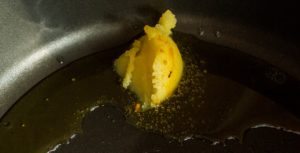
Which is healthier: ghee or butter
The structure of the product differs significantly from butter, and in general, from all animal fats. Its main component is unsaturated fatty acids. Their share in the total mass can reach 35%, while in butter they are only 24%. Ghee has a higher content of vitamins A, D and E.
The rest of the products are similar and, one might say, identical.
However, given that the product contains only fat without impurities and water, it is cleaner. And only high fat and very good quality butter can compete with it in terms of usefulness. Also, the product has a significant plus - almost an order of magnitude longer shelf life.
On the other hand, ghee has more calories, so if you consume the same amount of both products, the weight gain from it will be greater. But this factor is subjective, since someone should gain weight, and someone should lose.
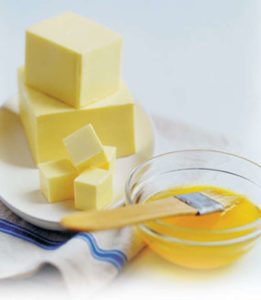
The harm of ghee and contraindications
This product has only one harm - an extremely high calorie content. When this product is abused, fat reserves in the body increase, obesity and related diseases develop. First of all, these are diseases of the cardiovascular system and gastrointestinal tract.
The overwhelming majority of contraindications to the use of ghee are related not to any diseases, but to the volume of its consumption. In small quantities, it has no harm and no contraindications. Since dairy components are removed from it when heating, even people with lactose intolerance can use it. Allergies from this product are extremely rare and sporadic.
If we approach the issue of contraindications from a formal point of view, then the use should be limited or used with caution for people with the following diseases:
- pancreatitis;
- cholecystitis;
- kidney disease;
- diseases of the immune system;
- diseases associated with obesity (hypertension, ischemia, heart attack, arthritis, etc.)
However, there are several diseases that have direct contraindications that completely prohibit the use of ghee in food. These include:
- diabetes;
- atherosclerosis;
- obesity of internal organs.
How to store ghee
It is recommended to store the product in hermetically sealed containers (jars with lids, bottles with a wide neck, etc.). At room temperature, its shelf life is about 9 months. If stored in a refrigerator, about a year. If a freezer is used for storage, then it does not lose its useful properties within a year and three months.
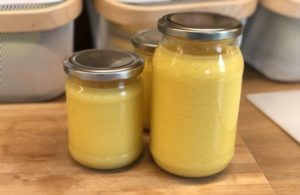
Conclusion
The benefits and harms of ghee do not raise any questions now. This wonderful pure and natural product is used in cooking, cosmetology and medicine. Its only drawback is its high calorie content, which significantly limits both the volume of its consumption and its availability for certain groups of people.

